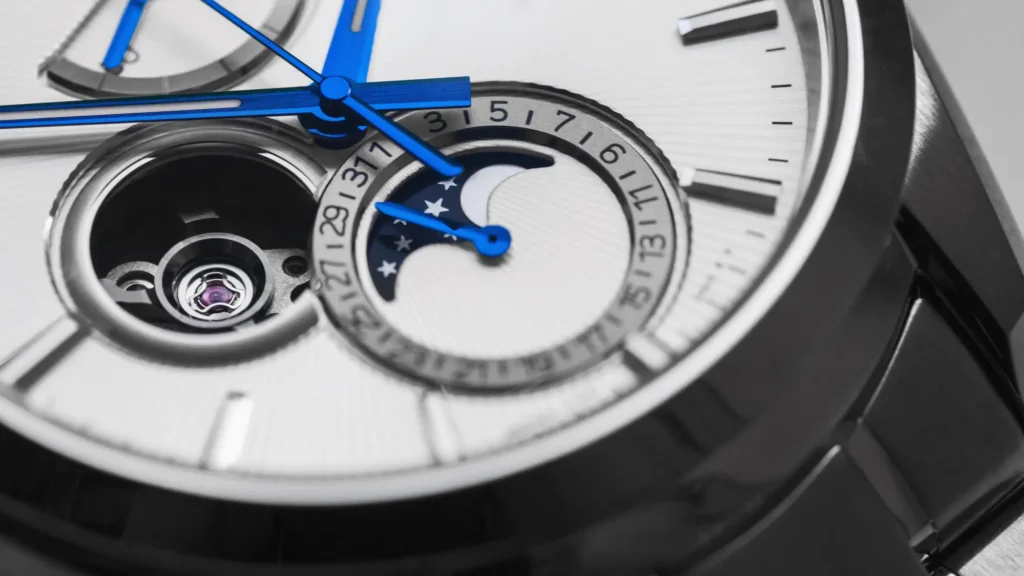Moon phase watches are a marvel of horological engineering, marrying the age-old craft of watchmaking with the poetic motion of the celestial bodies. These timepieces are not just instruments of timekeeping but also a window into the cosmos, worn on the wrist. The complexity of their mechanics has fascinated enthusiasts and collectors alike. To truly appreciate the intricacy of moon phase watches, one must delve into the gears and springs that power their lunar ballet.
The Poetry of Precision: The Moon Phase Complication
The moon phase complication is an elegant feature that displays the current phase of the moon as it appears in the sky. This complication is not only a technical achievement but also an artistic one, often featuring a miniature painting or engraving of the moon against a starry background. The display typically cycles moon phase watch mens the new moon, first quarter, full moon, and last quarter, reflecting the synodic month of approximately 29.5 days.
The Heart of the Matter: The Movement
At the heart of a moon phase watch is its movement, or caliber, which is the engine that drives both the timekeeping functions and the moon phase display. There are two main types of movements that can feature moon phase complications:
- Mechanical Movements: These movements are powered by a coiled spring and are either manually wound by the wearer or automatically wound by the movement of the wearer’s wrist.
- Quartz Movements: These electronic movements are powered by a battery and use a quartz crystal to regulate timekeeping. They are less common in moon phase watches due to the traditional nature of the complication.
Regardless of the type, the movement must be precisely engineered to accurately reflect the moon’s cycle.
The Lunar Mechanism: How it Works
The mechanism behind a moon phase watch is a testament to human ingenuity. Here’s how it typically works:
- Driving Wheel: The movement has a wheel that completes one full rotation every 24 hours. This is linked to the hours of the day.
- Moon Phase Disc: Attached to the driving wheel is a moon phase disc. This disc has two identical moons painted on it and is geared to make one full rotation every 59 days.
- The Gear Train: The ratio between the driving wheel and the moon disc is critical. For a standard gear train, the gear ratio is set so that the moon phase indicator advances one day for every two revolutions of the 24-hour wheel, aligning with the 29.5-day lunar cycle.
- The Display: A small aperture on the watch face reveals only a portion of the moon phase disc. As the disc turns, different portions of the moons become visible, simulating the waxing and waning of the actual moon.
Calibrating the Heavens: Setting and Adjusting the Moon Phase
Setting a moon phase watch involves aligning the displayed moon with the current phase of the moon in the sky. It is usually done by advancing the time forward until the moon phase indicator matches the current lunar phase. The precision of the watch’s mechanism means that it will only require adjustment every few years; a well-crafted moon phase watch might be accurate for 122 years or more before needing a one-day correction.
The Challenge of Precision: Making a Moon Phase Watch Accurate
The traditional moon phase mechanism, while beautiful, is not perfectly accurate. A lunar month is not exactly 29.5 days but rather approximately 29.53059 days. This means that a standard moon phase watch, if left unadjusted, will be off by one day every two and a half years or so. To combat this discrepancy, some high-end moon phase watches incorporate more complex mechanisms with gear ratios designed to extend the accuracy of the display to hundreds or even thousands of years.
Conclusion: A Timeless Dance of Complexity and Beauty
Moon phase watches are a testament to the enduring human desire to capture and express the natural rhythms of our universe. The complex mechanics behind these timepieces are not just about technical achievement; they are also about honoring our connection to the cosmos. For the watch enthusiast, owning and understanding a moon phase watch is not just about telling time; it’s about carrying a piece of celestial harmony with them wherever they go.


